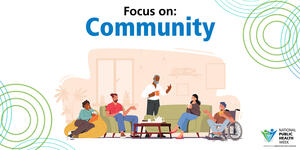Everyone deserves to live in an equitable, safe, healthy, and just community and pedestrian safety is a major component to creating this reality. This week there are several opportunities to celebrate and center the importance of having safe and convenient places to walk for people of all ages and abilities. See below for more details!
National Walking Day on Wednesday, April 5, 2023
The American Heart Association (AHA) encourages you to celebrate National Walking Day on April 5 and the entire month by accepting the challenge to move more. A 2022 study, published in the Journal of American Medical Association, found that increasing daily activity by just 10 minutes a day could help to save more than 100,000 lives a year.
Not sure where to start? Take a walk on Wednesday, April 5 to celebrate National Walking Day!
Walk to Work Day on Friday, April 7, 2023
Walk to Work Day is an annual event to highlight the benefits of walking a portion or all of your commute. Not only does walking to work provide health benefits, it also helps the planet! By walking instead of driving, participants are lowering their carbon footprint and highlighting the importance for safe, comfortable routes for those walking to and from work. Walking to work is one way to support the planet and your health!
National Public Health Week, April 3 - 9, 2023
This week is also National Public Health Week (NPHW), and this year's focus is on how we can all make our communities healthier, safer and stronger when we support and stay engaged with one another. The main goal of NPHW this year is to look at how cultural connections and intersections affect our health, well-being and the public health system that cares for us.
Having a walkable community benefits everyone, through the promotion of benefits like improved fitness, reduced health risks, and a greater sense of community. See the NPHW website for more information and how to celebrate!
Unfortunately, pedestrian injuries and fatalities continue to rise. According to the latest Pedestrian Traffic Fatalities by State: 2022 Preliminary Data report by the Governor’s Highway Safety Association (GHSA), pedestrian deaths have surged 18%, or 519 additional lives lost, between the first half of 2019 and 2022. Nationally, there were 1.04 pedestrian deaths per 100,000 people in 2022, up significantly from 0.90 in 2019. Visit the GHSA website for more data both nationally and by state.
Interested in how you can help create a safe community for those walking? Check out the tips below from the National Highway Traffic Safety Administration (NHTSA).
Safety Tips for People Driving
-
Look out for pedestrians everywhere, at all times.
-
Use extra caution when driving in hard-to-see conditions, such as nighttime or bad weather.
-
Slow down and be prepared to stop when turning or otherwise entering a crosswalk.
-
Yield to pedestrians in crosswalks and stop well back from the crosswalk to give other vehicles an opportunity to see the crossing pedestrians so they can stop too.
-
Never pass vehicles stopped at a crosswalk. There may be people crossing where you can’t see.
-
Never drive under the influence of alcohol and/or drugs.
-
Follow the speed limit, especially around people on the street, in school zones and in neighborhoods where children are present.
-
Be extra cautious when backing up and look for pedestrians.
Safety Tips for People Walking
-
Follow the rules of the road and obey signs and signals.
-
Walk on sidewalks whenever they are available.
-
If there is no sidewalk, walk facing traffic and as far from traffic as possible.
-
Cross streets at crosswalks or intersections. Look for cars in all directions, including those turning left or right.
-
If a crosswalk or intersection is not available, locate a well-lit area where you have the best view of traffic. Wait for a gap in traffic that allows enough time to cross safely; continue watching for traffic as you cross.
-
Watch for cars entering or exiting driveways, or backing up in parking lots.

